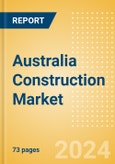The construction industry is expected to record an average annual growth of 2.8% from 2025 to 2028, supported by investment in the housing, renewable energy, health, education, and manufacturing sectors. Growth will also be driven by investment as part of the National Road Safety Action Plan (2023-25), which outlines the steps that the federal, state, and territorial governments will undertake to decrease road accidents and casualties. The plan focuses on nine key areas, one of which is planning and investment in infrastructure. In February 2024, the Australian government and Queensland government jointly announced a funding of AUD511.5 million ($332.8 million) for this initiative which will be used to deliver 71 projects for safety upgrades across Queensland.
Forecast-period growth in the industry will also be supported by the significant investment announced as part of several state government budgets. In its Financial Year (FY) 2023-24 (July 2023 to June 2024 Budget), the state government of Tasmania announced AUD2.2 billion ($1.4 billion) for the development of transport infrastructure over the next four years. The Tasmanian government also plans to invest AUD12.1 billion ($7.9 billion) until 2027 to upgrade healthcare infrastructure in the state. Furthermore, the Tasmanian government plan to invest AUD1.5 billion ($976 million) in the construction of 10,000 new social and affordable homes by 2032. In February 2024, the Tasmanian government announced it plans to develop an additional 2,000 more houses by 2027.
GlobalData’s Construction in Australia - Key Trends and Opportunities by State and Territory to 2028 (Q1 2024) report provides detailed market analysis, information, and insights into the Australian construction industry, including :
- The Australian construction industry's growth prospects by market, project type, and construction activity
- Critical insight into the impact of industry trends and issues, as well as an analysis of key risks and opportunities in the Australian construction industry
- Analysis of the mega-project pipeline, focusing on development stages and participants, in addition to listings of major projects in the pipeline.
Scope
This report provides a comprehensive analysis of the construction industry in Australia. It provides :
- Historical (2019-2023) and forecast (2024-2028) valuations of the construction industry in Australia, featuring details of key growth drivers.
- Segmentation by sector (commercial, industrial, infrastructure, energy and utilities, institutional and residential) and by sub-sector
- Analysis of the mega-project pipeline, including breakdowns by development stage across all sectors, and projected spending on projects in the existing pipeline.
- Listings of major projects, in addition to details of leading contractors and consultants
Reasons to Buy
- Identify and evaluate market opportunities using the analyst's standardized valuation and forecasting methodologies.
- Assess market growth potential at a micro-level with over 600 time-series data forecasts.
- Understand the latest industry and market trends.
- Formulate and validate strategy using the analyst's critical and actionable insight.
- Assess business risks, including cost, regulatory and competitive pressures.
- Evaluate competitive risk and success factors.








